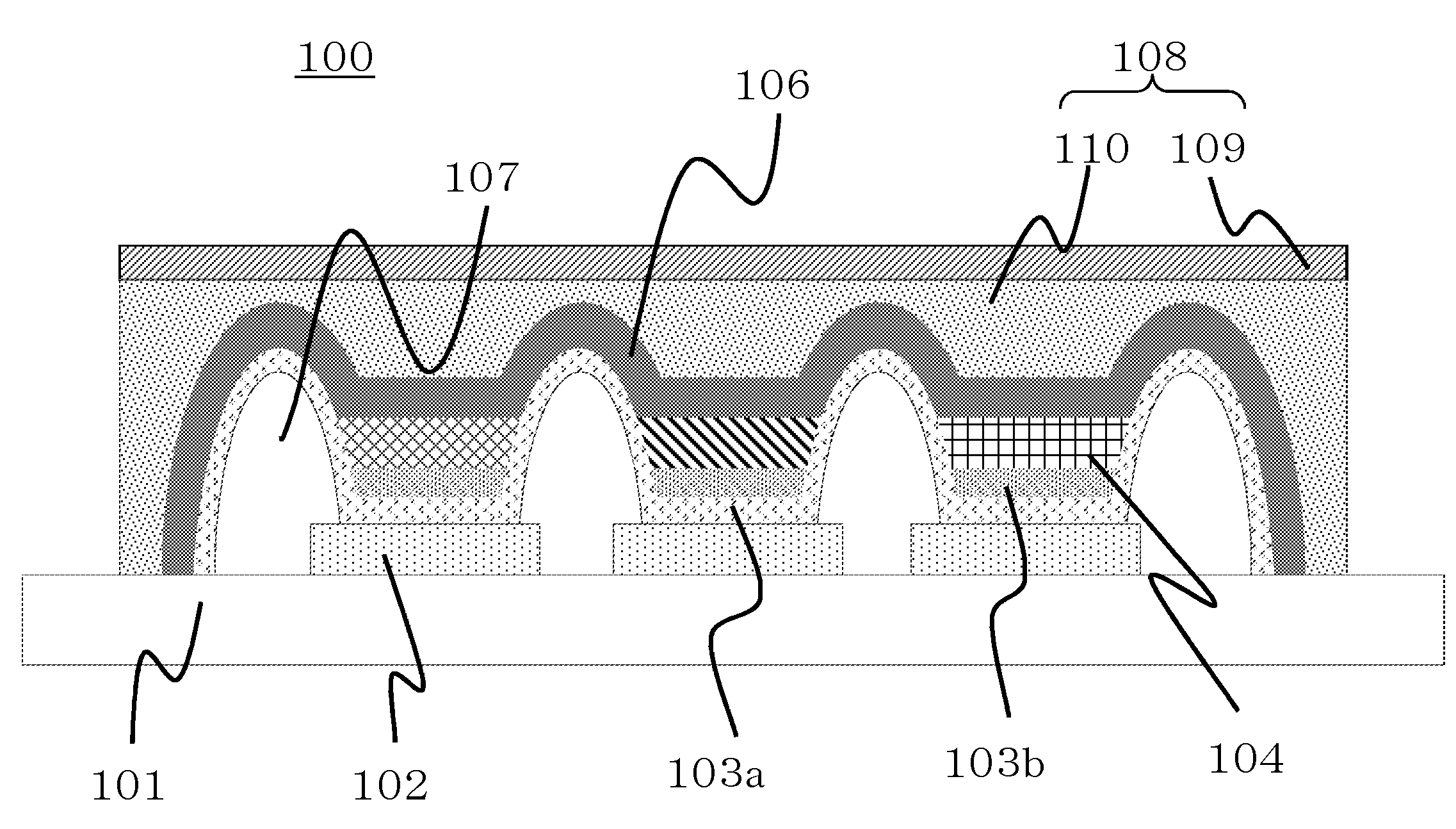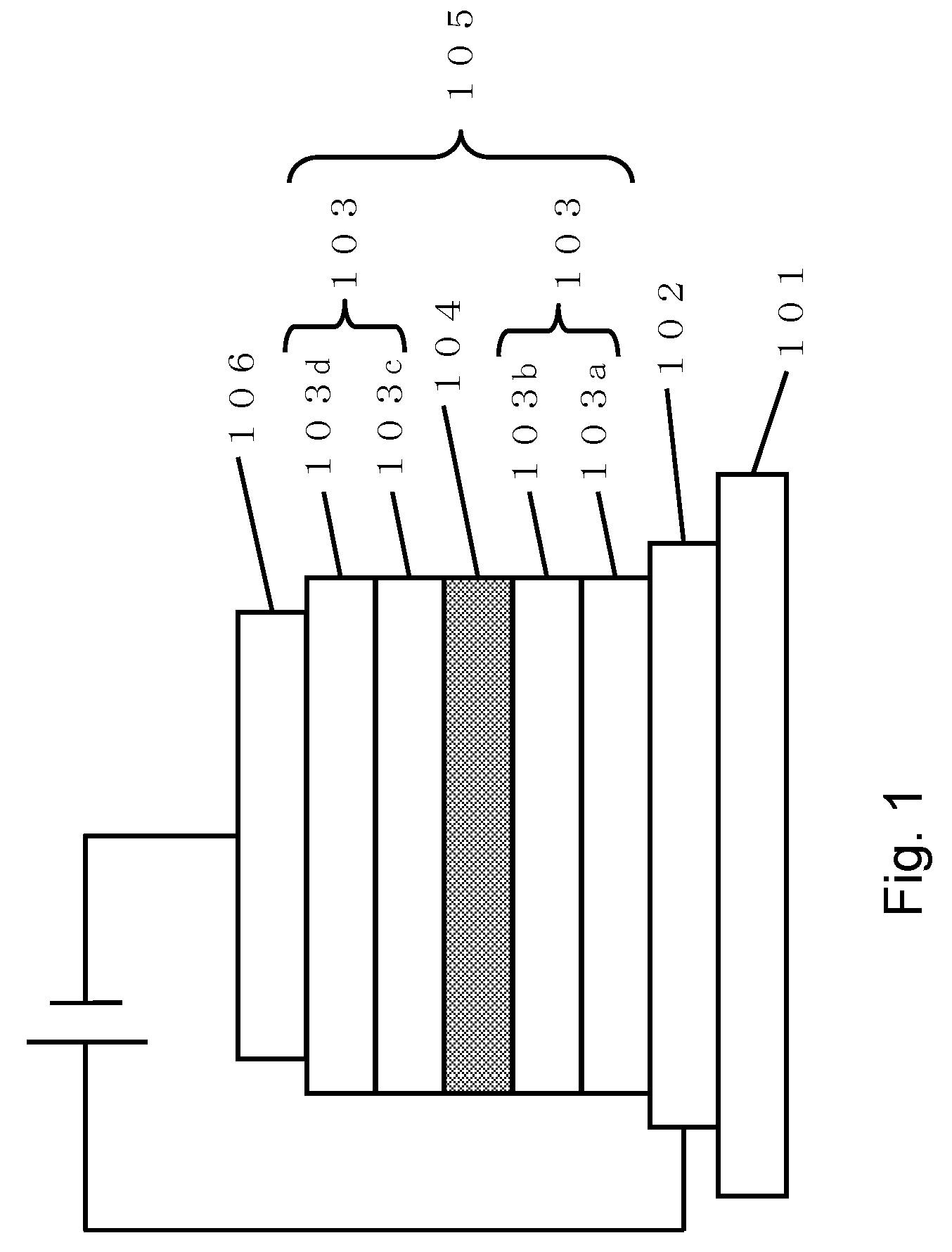Organic electroluminescence element, display device using organic electroluminescence element, and method of manufacturing organic electroluminescence element
a technology of organic electroluminescence and display device, which is applied in the direction of organic semiconductor devices, thermoelectric devices, solid-state devices, etc., can solve the problems of insufficient tolerance, inability to achieve satisfactory combinations of first and second metal compounds in some cases, and inability to achieve satisfactory combinations of first and second metal compounds. achieve high luminance luminescence, long lifetime, and high efficiency
- Summary
- Abstract
- Description
- Claims
- Application Information
AI Technical Summary
Benefits of technology
Problems solved by technology
Method used
Image
Examples
example 1
[0129]First, a glass substrate is used as the substrate. ITO as a material of the anode was formed on the substrate in a vacuum by a sputtering method and the ITO film was patterned by a photolithography method and etching of an acid solution to form a luminescent electrode section.
[0130]Next, an acrylic-based photoresist material was spin-coated as the material of an insulation layer on the entire surface of the glass substrate on which the luminescent electrode section was formed. As the condition of the spin coating, the acrylic-based photoresist material was rotated for five seconds at 150 rpm, and then was for twenty seconds at 500 rpm to obtain a conductive film with a height of 1.5 μm. Thereafter, a pattern with a lattice shape was formed by a photolithography method on the luminescent electrode section.
[0131]Next, molybdenum oxide and titanium oxide were co-deposition as the hole-injection layer and the hole-carrying layer in a vacuum and the deposition speed of the titanium...
example 2
[0136]An element was manufactured by the use of the same method and material as those of Example 1. At this time, the mixture gradient film was formed with a gradient so that the concentration of titanium oxide was 66 wt % on the side of the anode and was 0 wt % on the side of the cathode. The mixture ratio of the mixture gradient film was obtained with the gradient shown in the right lower side of FIG. 10.
[0137]The luminescent of the formed organic EL element was good without irregularity or a dark spot. The luminance at 7 V was 1360 cd / m2 and a luminance half-life time at initial luminance of 1500 cd / m2 was 290 hours, and thus the element characteristics of low-voltage driving, high luminance, and long lifetime were obtained. Further, a defect such as a dark spot was not recognized at an acceleration experiment.
example 3
[0138]An element was manufactured by the use of the same method and material as those of Example 1. At this time, the mixture gradient film was formed with a gradient so that the concentration of titanium oxide was 12 wt % on the side of the anode and was 62 wt % on the side of the cathode. The mixture ratio of the mixture gradient film was obtained with the gradient shown in FIG. 6.
[0139]The luminescent of the formed organic EL element was good without irregularity or a dark spot. The luminance at 7 V was 1280 cd / m2 and a luminance half-life time at initial luminance of 1500 cd / m2 was 325 hours, and thus the element characteristics of low-voltage driving, high luminance, and long lifetime were obtained. Further, a defect such as a dark spot was not recognized at an acceleration experiment.
PUM
| Property | Measurement | Unit |
|---|---|---|
| thickness | aaaaa | aaaaa |
| thickness | aaaaa | aaaaa |
| thickness | aaaaa | aaaaa |
Abstract
Description
Claims
Application Information
 Login to View More
Login to View More - R&D
- Intellectual Property
- Life Sciences
- Materials
- Tech Scout
- Unparalleled Data Quality
- Higher Quality Content
- 60% Fewer Hallucinations
Browse by: Latest US Patents, China's latest patents, Technical Efficacy Thesaurus, Application Domain, Technology Topic, Popular Technical Reports.
© 2025 PatSnap. All rights reserved.Legal|Privacy policy|Modern Slavery Act Transparency Statement|Sitemap|About US| Contact US: help@patsnap.com



